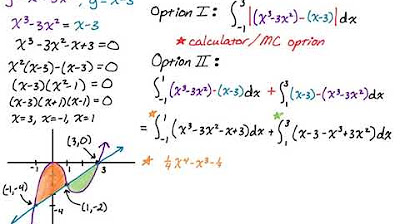Type I regions in three dimensions | Divergence theorem | Multivariable Calculus | Khan Academy
TLDRThis video script delves into the concept of three-dimensional regions, specifically focusing on 'Type 1 regions.' It begins with a formal definition, explaining that these regions are sets of points where x and y belong to a domain and z varies between two functions of x and y. Examples like a sphere and a cylinder are used to illustrate Type 1 regions, while a dumbbell shape is given as a counterexample, highlighting the importance of the z-values being bounded by a single lower and upper function for a region to be classified as Type 1.
Takeaways
- 📚 The video discusses the concept of 'type 1 regions' in three-dimensional space, which are essential for evaluating double and triple integrals and proofs in multivariable calculus.
- 📐 A type 1 region is formally defined as a set of points where x and y belong to a certain domain, and z varies between two functions of x and y, f1(x, y) and f2(x, y).
- 🌐 The video provides a visual representation of type 1 regions, starting with a formal definition followed by illustrations to aid understanding.
- 🎨 Examples of type 1 regions include a sphere and a cylinder, where the x-y plane intersection defines the domain, and z values are bounded by two functions.
- 🏐 The video clarifies that a sphere can be considered a type 1 region, with the bottom and top halves representing the lower and upper bounds of z, respectively.
- 📏 The cylinder example demonstrates that the x-y plane does not have to be inside the region and that the top and bottom surfaces can be defined by two functions.
- 🚫 The video explains what would not constitute a type 1 region, using the example of a 'sideways dumbbell' shape that cannot be bounded by just two functions of z.
- 🔍 The script emphasizes the importance of understanding the limitations of type 1 regions by considering cross-sections and the impossibility of defining z values between a single lower and upper bound.
- 📉 The 'dumbbell' shape is disqualified as a type 1 region because it requires breaking it into separate regions where z can take on all values between two bounds for each x, y pair.
- 🔄 The video suggests that complex shapes like the 'dumbbell' can be decomposed into multiple type 1 regions, each with its own domain and bounding functions.
- 👀 The script concludes by suggesting an alternative perspective, considering the z-y plane to illustrate why certain shapes cannot be defined as a single type 1 region due to multiple z-values for a given y.
Q & A
What is the purpose of exploring different types of three-dimensional regions in the video?
-The purpose is to understand how to evaluate different double and triple integrals and to provide insights into interesting proofs in multivariable calculus.
What is a type 1 region in three dimensions?
-A type 1 region is a set of all points (x, y, z) in three dimensions where x and y are part of a domain, and z varies between two functions of x and y, f1(x, y) and f2(x, y).
How does the video define the lower and upper bounds of a type 1 region?
-The lower bound of a type 1 region is defined by a function f1(x, y), and the upper bound is defined by another function f2(x, y), with z being less than or equal to both.
Can you give an example of a type 1 region?
-A sphere is a simple example of a type 1 region, where the domain D is the intersection of the sphere with the x, y plane, and the bounds are the bottom and top halves of the sphere.
What is another example of a type 1 region mentioned in the video?
-A cylinder above the x, y plane is another example, where the domain is in the x, y plane and the bounds are the bottom and top surfaces of the cylinder.
What is a characteristic of the top and bottom surfaces of a type 1 region?
-The top and bottom surfaces of a type 1 region can be flat or curvy, and they define the range of z values for each (x, y) pair in the domain.
Why is a dumbbell or hourglass shape not considered a type 1 region?
-A dumbbell or hourglass shape is not a type 1 region because it cannot be defined with just one lower and one upper bound function in terms of z for any given (x, y) pair.
How can a dumbbell shape be represented in terms of type 1 regions?
-A dumbbell shape can be broken up into two separate type 1 regions, with each region having its own lower and upper bound functions for z.
What is the significance of the domain D in the context of a type 1 region?
-The domain D represents all the possible x and y values that can be part of the type 1 region, and it is essential for defining the range of z values.
How does the video illustrate the concept of a type 1 region using a cylinder?
-The video illustrates a type 1 region by drawing a cylinder above the x, y plane, showing how the domain in the x, y plane corresponds to the bottom surface and how the top surface is the upper bound of z values.
What is the main takeaway from the video regarding the evaluation of double and triple integrals?
-The main takeaway is that understanding different types of three-dimensional regions, such as type 1 regions, is crucial for effectively evaluating double and triple integrals and for proofs in multivariable calculus.
Outlines
📚 Introduction to Type 1 Regions in 3D Space
The script begins by introducing the concept of Type 1 regions in three-dimensional space, which are essential for evaluating double and triple integrals and proofs in multivariable calculus. The speaker aims to define Type 1 regions formally and then provide visual examples to aid understanding. A Type 1 region is characterized by a set of points where x and y belong to a certain domain, and z varies between two functions of x and y. The lower bound is represented by f1(x, y) and the upper bound by f2(x, y). The speaker illustrates this with examples such as a sphere and a cylinder, explaining how these shapes fit the criteria of a Type 1 region.
🚫 Understanding Non-Type 1 Regions with a Dumbbell Shape
In the second paragraph, the script discusses shapes that do not qualify as Type 1 regions, using the example of a sideways dumbbell or an hourglass shape. The speaker attempts to draw this shape and explains why it cannot be defined by a single lower and upper function in terms of z. The key point is that for any given x and y, z does not take on all values in between the two bounding functions, which is a requirement for a shape to be classified as a Type 1 region. The speaker suggests that such a shape would need to be broken down into separate regions to fit the Type 1 region criteria, and also provides an alternative perspective by considering the z-y plane to further clarify why the dumbbell shape does not meet the definition.
Mindmap
Keywords
💡Type 1 Region
💡Double and Triple Integrals
💡Multivariable Calculus
💡Formal Definition
💡Domain
💡Lower Bound
💡Upper Bound
💡Sphere
💡Cylinder
💡Non-Type 1 Region
Highlights
Introduction to exploring different types of 3D regions useful for evaluating double and triple integrals and multivariable calculus proofs.
Definition of a Type 1 region as a set of points (x, y, z) where x and y belong to a domain and z varies between two functions of x and y.
Formally defining Type 1 regions with an example of a sphere as a simple Type 1 region.
Drawing the domain D on the x, y plane for the sphere example.
Describing f1(x, y) as the lower bound and f2(x, y) as the upper bound for z in the sphere example.
Visualizing the bottom and top halves of the sphere as f1 and f2 respectively.
Presenting a cylinder as another example of a Type 1 region, with its domain and boundaries.
Explaining that the domain does not have to be inside the region, using the cylinder example.
Describing how the bottom and top surfaces of the cylinder are defined by f1 and f2 functions.
Clarifying that the surfaces defining a region can be curvy, not just flat.
Discussing the concept of a shape that cannot be defined as a Type 1 region, like a sideways dumbbell or hourglass shape.
Drawing and explaining why a dumbbell shape does not fit the definition of a Type 1 region due to its cross-section.
Describing the limitations of defining z values between a single lower and upper bound function for complex shapes.
Suggesting that complex shapes like a dumbbell can be broken down into multiple Type 1 regions.
Providing an alternative perspective by considering the z-y plane to further explain the limitations of Type 1 regions for certain shapes.
Highlighting the importance of understanding the limitations of Type 1 regions for evaluating integrals and proofs in multivariable calculus.
Transcripts
Browse More Related Video

Type II regions in three dimensions | Divergence theorem | Multivariable Calculus | Khan Academy

Type III regions in three dimensions | Divergence theorem | Multivariable Calculus | Khan Academy

AP Calculus Exam Tip: Definite Integral of Absolute Value Function

Divergence theorem proof (part 5) | Divergence theorem | Multivariable Calculus | Khan Academy

Area Between Two Curves with Multiple Regions: y = x^3-3x^2 and y = x-3

Calculus AB Homework 7.5 Shell Method
5.0 / 5 (0 votes)
Thanks for rating: